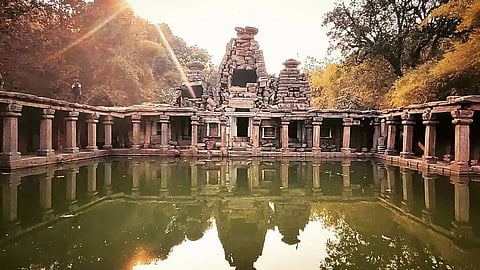
- Destinations
- Experiences
- Stay
- What's new
- Editor’s Picks
- Responsible Tourism
- CampaignsCampaigns
- Subscribe

The Karpur Baoli is a 12th-century stepwell in the temple complex of Ramtek in Nagpur, Maharashtra. Stepwells such as this were a common feature in the architectural design of many historical monuments. These served as water reservoirs for irrigation and general consumption.
Locals say the water level in this 1200-year-old tank never goes down. A visitor might spend many peaceful hours roaming about the temple complex, admiring the exquisite architectural architecture and sculptures. The building is presently crumbling, and the location is relatively unknown making this a hidden treasure near Nagpur.
The name is a blend of two words: "Karpur" meaning "camphor," and "Baoli" meaning "water tank." The water in the well is supposed to have the medicinal benefits of camphor.
Constructed by the rulers of the Yadava dynasty between the 10th and 12th centuries A.D., this old baoli is dedicated to six goddesses and is a few km from the Ramtek temples. A ruined temple known locally as the Kali Mata Temple sits on one end of the Karpur Baoli. The baoli was an important source of water in dry seasons.
The goddesses Bhairavi, Chamunda, Ingalaj, Ranchandi, Kali, and Kapurta are honoured at the Karpur Baoli. The Garbhagriha (Shrine Room) features a half-completed sculptured panel. The shrine also has pillared passageways and the architectural style is reminiscent of the Harappa culture.
The pond artistically reflects the building. There is currently a scarcity of accurate information in this field. However, now that the Archaeological Survey of India has assumed ownership, the pond and building are likely to be cleaner and better kept.
The Baoli is built in the Hemadpanti style of the medieval period of the Deccan known for its aesthetics and functional design principles. The stepwell is 60 feet deep and rectangular in design. The shrine has a lingam, a symbol of Lord Shiva, and is thought to have been built about the same time as the stepwell.
Ramtek Fort is a medieval fort situated on a hilltop in Ramtek. The fort was constructed in the 18th century and served as a crucial site during the rule of the Nagardhan dynasty. Visitors may explore the fort and take in the surrounding scenery.
Khindsi Lake is a beautiful lake around 10 km from Ramtek. The lake is bordered by lush green woodlands and is a popular boating and fishing destination. Visitors may also go for a picnic and enjoy the natural beauty of the region.
Mansar is a medieval town approximately 30 km from Ramtek. The town is famous for its old temples, such as the Mansar Devi Temple and the Lakshmi Narayan Temple. Visitors may visit the temples and see the stunning architecture and elaborate sculptures.
Sevagram Ashram is an ancient ashram located roughly 70 km from Ramtek. Mahatma Gandhi established the ashram in 1936 as the focal point of the Indian independence struggle. Visitors can tour the ashram and learn about the history of the Indian freedom movement.
Deekshabhoomi is a medieval Buddhist stupa in Nagpur, around 45 km from Ramtek. The stupa is both a Buddhist pilgrimage site and a famous tourist attraction. Visitors may examine the stupa and learn about Buddhism in India's history.
It is a medieval temple approximately 60 km from Ramtek. The temple, which is dedicated to Lord Ganesha, is notable for its distinctive architecture and beautiful sculptures.
Visitors may take a cab or a private vehicle from Nagpur, which is around 50 km away, to Karpur Baoli. The monsoon season, from July to September, is the finest time to visit Karpur Baoli because the stepwell is filled with water and is at its most picturesque.
The Baoli is surrounded by thick woods, and you must walk a short distance from the road to park your vehicle securely.
